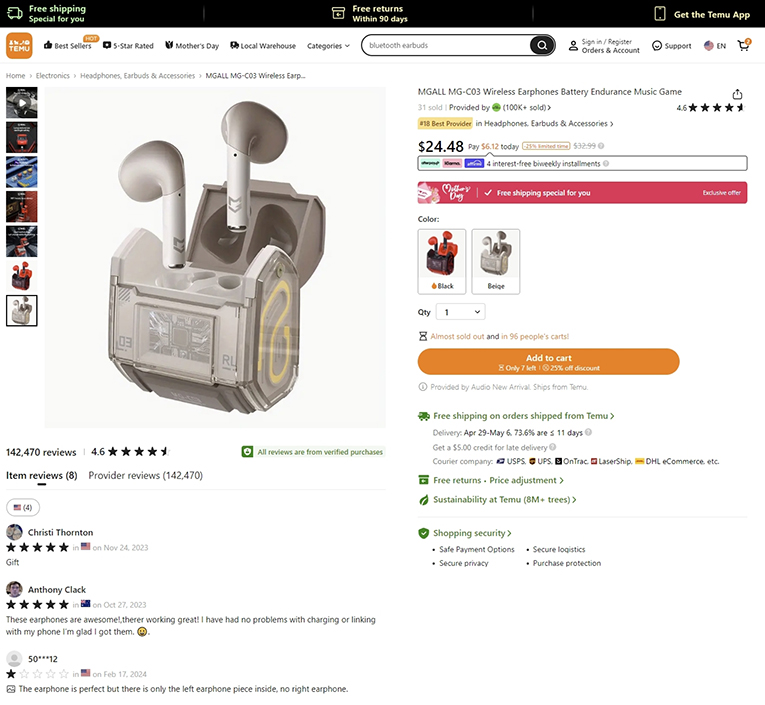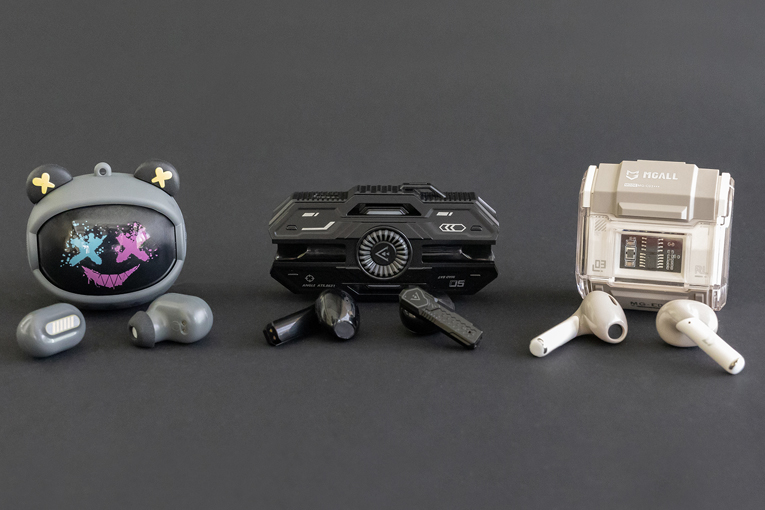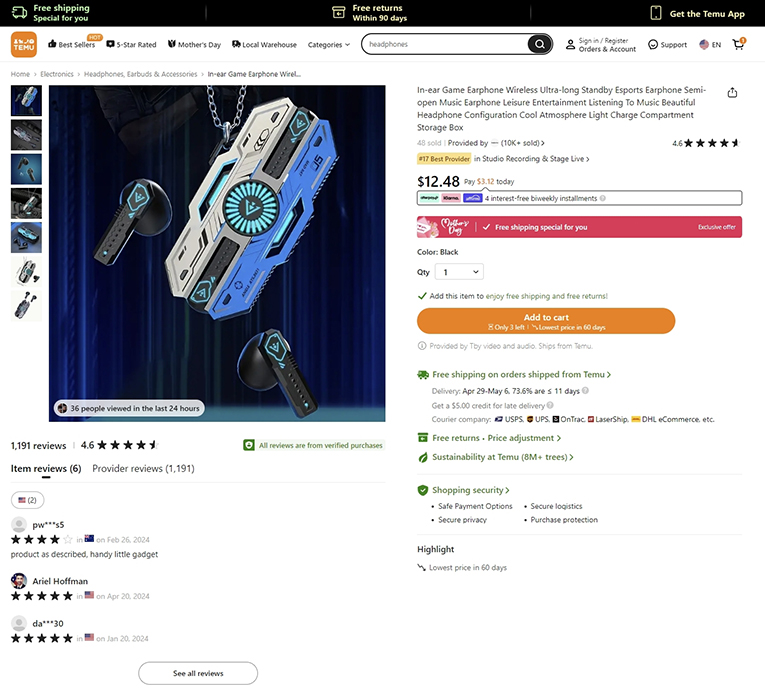If you’ve never heard of Temu, it’s an online marketplace similar to Amazon, Etsy, and what eBay has become. Broadly speaking, it’s a way for consumers to purchase products more or less directly from manufacturers. Said products are usually shipped straight from China. Quite often—and this is why Temu has become so popular—it’s a way to get extremely inexpensive products. Are they high quality? Absolutely not, but they are highly cheap.
Even the most casual of digging reveals a veritable smorgasbord of dicey or flat-out icky business practices by Temu itself (or, more accurately, its owner, Whaleco Technology Limited) and the various companies that use the platform. We’ll get into the ethics of all that at the end.

For now, let’s talk about earphones. Specifically, impossibly cheap, no-name, Temu-sold true wireless earphones. I spent a few hours scouring the seemingly infinite amount of audio gear on the Temu site. Some products I could find elsewhere (Google Image Search is very handy); others featured designs that were “influenced” by well-known brands. I settled on three that at least looked interesting and spent a total of $61.26 including tax and shipping. I’ll admit I was impressed at the level of communication (automated of course) from Temu, updating me regularly about the status of my order and the various stages of shipping. The time from order to delivery was ten days. That’s an eternity in this era of Amazon’s next-day delivery, but hey, I got three pairs of true wireless earphones for $60! I also now have multiple emails a day from Temu trying to get me to buy more. Such is modern life, I suppose.
Since most companies that use Temu lack the budgets of larger brands, it’s not surprising that the earphones I purchased didn’t have the marketing polish of the big names. No simple “Ultra” or “Studio” product names here. For example, the product name for one was—and I quote this verbatim—“In-Ear Game Earphone Wireless Ultra-long Standby Esports Earphone Semi-Open Music Earphone Leisure Entertainment Listening to Music Beautiful Headphone Configuration Cool Atmosphere Light Charge Compartment Storage Box.” How pithy. Upon arrival, a sticker on the box said they were made by Shenzhen Chaoyin Electronics Co, LTD, with a product name of TWS/X37, so I’ll call them the SCE X37s. They cost $12.48.

The closest to name-brand earphones are the T20s from Onikuma, a company that also makes some gaming headsets a colleague had heard of. These feature an adorable smirking bear-esque head that actually has some clever design to it. These, along with the SCEs, were interesting enough to warrant full reviews. Coming in at a whopping $24.48 were the Mgall MG-C03 earphones. These had an impressive case. Their sound, however, was the least interesting of this trio.
Mgall MG-C03 mini review
The Mgall MG-C03s have a boxy, sci-fi-inspired case with curvy waveguides on the side lit by RGB LEDs. I don’t know if most buyers agree, but I for one would like to see more gear that looks like it’s from the future. Or at least the future from TV shows and movies. On the front of the case are visible surface-mount transistors and capacitors. No idea if these are functional, but the one with a readable label is a SY8825, which is apparently a power-management integrated circuit for use in true wireless earbuds. According to a sticker on the box, which looked like the tech equivalent of a nutrition label, these were made by Shenzhen Qishun Innovation Technology Development Co, LTD. Now that’s a mouthful. Perhaps it’s easier to say in Mandarin.

Inside the box was a small instruction booklet and a USB-A-to-USB-C charging cable. Honestly, for the premiere price of $24.50, I was expecting more. The instruction booklet was entirely in Chinese.
The earbuds were fairly comfortable, which wasn’t too surprising, since they seem to have copied the original AirPod design whole-hog. Let’s call it “legal-adjacent inspiration.” They hated my Pixel 7, never once automatically reconnecting. I’d have to manually select them each time. They would connect to my Sony NW-A306 player, which runs an older version of Android.
The MG-C03s sound . . . fine. Not good by any stretch, but they produce sound that’s listenable, which is about the faintest praise I can muster above “this is a thing that exists.” They’re practically all treble. If you like snare drums, you’re in for a treat because they’re always front and center. There isn’t as much sibilance as you might expect from cheap, treble-heavy earbuds. There’s some, but not a cringeworthy amount. There are hints of bass, like a tuba player lurking around the corner. They play a little louder than the Onikuma T20s, so there’s that.

So are they good for $24? Kinda, I guess? If you’re not into the design of the Onikumas, and don’t want to risk the bizarreness of the X37s (check out their review for more detail), the MG-C03s do, at the very least, work. They’d be fine for podcasts or for someone who just wants “sound” and doesn’t care about the quality. I’m certainly not going to disparage anyone trying to get music on a tight budget, but there are better-sounding wired earphones for this or less money.
Temu the terrible?
I’m going to attempt the most difficult task on the internet: a nuanced discussion. If we look at these Temu headphones from an audiophile standpoint, they’re terrible. None of them sound “good” by any subjective measure. There are plenty of inexpensive true wireless options from brands such as Soundcore that actually sound quite good. Those also offer features like weather resistance, apps, and with any luck, the ability to actually connect to your phone automatically when you take them out of their case. It’s easy to poke fun at ultra-cheap products in a category that extends upward to the thousands of dollars.
And you know what? It’s fun! These are products that people are spending money on, and if they’re bad, it’s necessary to say so. And if we can have fun doing it, why not? However, people are spending money on these, and there’s the nuance. We live in an expensive world, and most headphones are a luxury. If these are all someone’s budget allows, that’s valid. It’d be far too flippant to say, “Don’t buy these $20 earbuds; get these $100 ones instead.” To someone considering $20 earbuds, $100 may be out of reach. To that person, I’d say wired earbuds can offer far better sound quality for the same money, with less chance of loss due to a stray bump or brush of hair.

With all that in mind, I’m not sure I can wholly dismiss Temu as some have. Are its business practices worse than others? Probably, but where do you draw that line? Can you guarantee every part of every product you own was made in a 100 percent ethical fashion? Nope. Does that mean we should all just resign ourselves to dystopia? Also no. Everyone is going to have their own way of making these judgments, and I’m not sure where the ethical line should be drawn. I am sure I shouldn’t be the one to figure that all out. All I know is I found some true wireless earbuds for less than a bowl of poke, and that is, in itself, fascinating and worthy of discussion.
. . . Geoffrey Morrison





